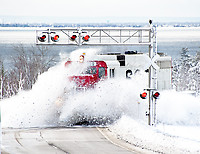It’s hard to explain it all, but there was one turning point that gave me a great interest in railroading: when I was fifteen, my brother who was not much older than I traveled by train (on a pass which our mother obtained because our father had worked for the ACL) from Charlotte, N. C., to New Orleans to Chattanooga and back to Charlotte, to visit our brother in Baton Roouge and an uncle in Chattanooga. Riding the all-day train from Birmingham to New Orleans, I tmost of the time standing at the rear, watching where we had been. It was wonderful to be moved along, without worry, from here to there.
Even though we spent two nights in coaches with walkover seats (the second night in such a car, my brother took the seat at the end of the car and was ble to stretch out) and only one in a coach with reclining seats, I was hooked for life.
We had two meals in diners–breakfast out of Birmingham on the way to Chattanooga, and dinner in the diner out of Chattanooga (going through the Missionary Ridge tunnel as we sat in the diner). While we were in Chattanooga, I learned something about how to play canasta, and offered to make a foursome when three young ladies in the lounge car on the Royal Palm were looking for a fourth (sad to say, I made a poor partner).
Two years later, I traveled by myself from Baton Rouge to Charlotte, again on a pass–and I spent the night from Atlanta to Charlotte stretched out on the seat at the end of the car, my most comfortable night ever when riding coach!
I felt that I was fortunate when living in Wesson, Miss., and Reform, Ala., to be able to interact with many railroad men–station agents and men in road service–and I was able to make up, in part, from not having trains to play with when young by playing with the real thing after I grew up.
Indeed, railroading had given me such an interest that for a time I thought that nothing could be better than to be a passenger conductor. Sad to say, I got only halfway there; most


